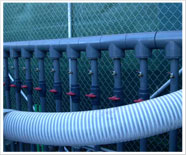Investigation and cleanup of PCE at dry cleaning facility
Los Angeles, California

Lindmark Engineering conducted several soil and groundwater assessments, performed a remedial investigation and feasibility study, and designed and installed a dual-phase extraction (DPE) system at a dry cleaning facility in Los Angeles, which existed on a strip mall in a high-rent area adjacent to Beverly Hills. The soils and shallow groundwater had been impacted by tetrachloroethene (PCE) and daughter products, and the downgradient extent of the PCE plume was more than 280 feet from the source area.
After the site was characterized, we installed and operated a DPE system, which extracted PCE from both the water and vapor phases. The remediation was complicated by dense, non-aqueous phase liquids present in soils and upper groundwater. The groundwater beneath the site consisted of two aquifers separated by a thin clay layer, and PCE had affected both aquifers. As outlined in our remedial action plan (RAP), we designed the DPE system so that the extraction wells targeted the soil zone, upper aquifer, and lower aquifer zones independently. After approximately five months of operation, the DPE system had extracted over 1,000 pounds of PCE from the shallow zones and was extracting groundwater at a rate of approximately 5,000 gallons per day. The PCE from both the soil and groundwater was being treated by activated carbon, and the treated groundwater was discharged into the local sewer system.
Due to litigation issues, our RAP preparation, remediation, and quarterly monitoring activities were conducted in accordance with National Contingency Plan (NCP) protocols. As part of NCP compliance, we included in our RAP a detailed field sampling plan, a quality assurance project plan, and a health and safety plan; and we prepared and carried out a community relations plan that outlined community involvement activities related to the selection of remedial alternatives and implementation of the remedial technology to be used for the site. A thirty-day public review period was established, during which we placed a public notice of the proposed remedial action in a local newspaper, prepared a project fact sheet and distributed it to the local tenants, established two local repositories where the RAP was made available to the public for review, and held a public meeting near the site to present the proposed remedial action.
Based on the progress made in remediating the site and the agency response to the cleanup, our client was able to successfully sell the property at a market price and the buyer assumed all obligations to further remediate the site.
For more information about this project and how we can accommodate you, please contact Lindmark Engineering.


